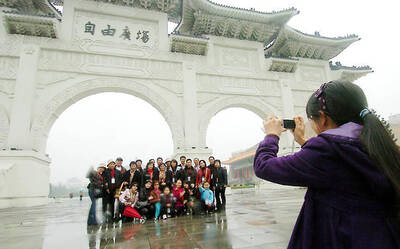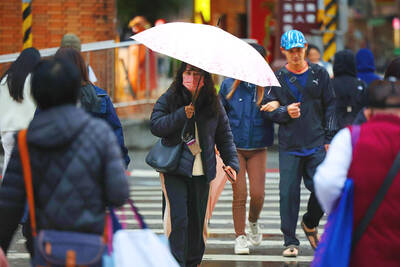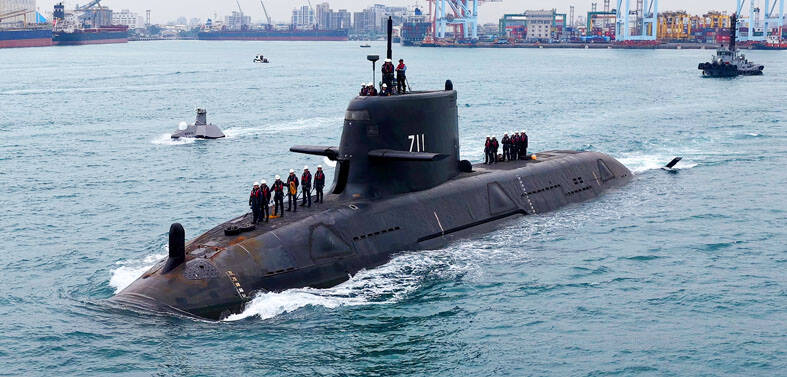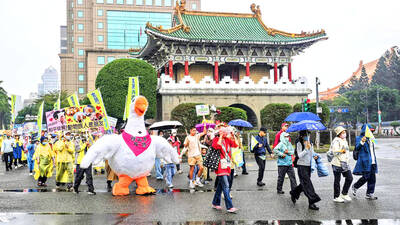The Democratic Progressive Party (DPP) says it is planning to propose an amendment to the Referendum Act (公民投票法) to lower the threshold it sets for passing referendums, 10 days after Premier Jiang Yi-huah (江宜樺) unexpectedly announced plans to put the continuation of construction of the Fourth Nuclear Power Plant to a popular vote.
Over the past week, the party has been unable to present a unified front on the proposal to ask voters if they support suspending construction of the Fourth Nuclear Power Plant in Gongliao District (貢寮), New Taipei City (新北市).
Former Democratic Progressive Party (DPP) chairperson Tsai Ing-wen (蔡英文) yesterday echoed a DPP-wide call for lowering the threshold for national referendums, saying that the passage of a referendum should be decided by simple plurality.

Photo: Lai Hsiao-tong, Taipei Times
The current laws on referendums require a voter turnout of at least 50 percent and a majority of 51 percent for the motion to be aproved, a threshold the DPP said was too high.
In response to the Chinese Nationalist Party’s (KMT) contention that Tsai supported the plant’s construction when she served as vice premier, the former DPP chairperson said the KMT was manipulating past events to fit its own purposes.
Tsai, who served as vice premier between 2006 and 2007, said the then-DPP Cabinet’s approval of the nuclear energy plant’s construction was based on Taiwan Power Co’s (Taipower) pledge to finish construction within the year.
After the approval was given, there were repeated accidents, construction delays, requests for additional budget allocations and the construction was never completed, she said.
At present, the public’s lack of confidence in Taipower and the government, coupled with the accident at the Fukushima Dai-ichi nuclear power plant in Japan two years ago “have completely changed the Taiwanese people’s views on nuclear energy.”
Tsai accused the KMT of handling the issue as a political maneuver, rather than treating it as an energy policy issue that affects people’s lives and public safety.
DPP Chairman Su Tseng-chang (蘇貞昌) is set to attend a DPP legislative caucus meeting today in the Legislative Yuan where the opposition party will try to formulate its final strategy on the matter.
DPP caucus converner Ker Chien-ming (柯建銘) said that the controversy over the Fourth Nuclear Power Plant has created “the most serious social division in recent memory, which is made more complex because it involves political rivalries and energy policy.”
Meanwhile, the DPP is ready to offer whatever support it can in the upcoming anti-nuclear energy demonstrations slated to be held simultaneously in Taipei, Taichung, Kaohsiung and Taitung on Saturday.
However, the DPP pledged to keep a low profile in the protests and would not send politicians to address the crowds. The rallies are being organized by anti-nuclear civic groups and are expected to draw at least 50,000 participants.
The civic groups launched the first “warm-up” demonstration yesterday in Jinshan (金山) District, New Taipei City, which is sandwiched between Shihmen (石門) and Wanli (萬里) districts, where the Jinshan and Guosheng nuclear power plants are located.
Hundreds of demonstrators marched in the street to protest in front of the two nuclear power plants, demanding that all three active plants suspend operations and that construction of the Fourth Nuclear Power Plant be stopped immediately.

NUMBERS IMBALANCE: More than 4 million Taiwanese have visited China this year, while only about half a million Chinese have visited here Beijing has yet to respond to Taiwan’s requests for negotiation over matters related to the recovery of cross-strait tourism, the Tourism Administration said yesterday. Taiwan’s tourism authority issued the statement after Chinese-language daily the China Times reported yesterday that the government’s policy of banning group tours to China does not stop Taiwanese from visiting the country. As of October, more than 4.2 million had traveled to China this year, exceeding last year. Beijing estimated the number of Taiwanese tourists in China could reach 4.5 million this year. By contrast, only 500,000 Chinese tourists are expected in Taiwan, the report said. The report

Temperatures are forecast to drop steadily as a continental cold air mass moves across Taiwan, with some areas also likely to see heavy rainfall, the Central Weather Administration (CWA) said. From today through early tomorrow, a cold air mass would keep temperatures low across central and northern Taiwan, and the eastern half of Taiwan proper, with isolated brief showers forecast along Keelung’s north coast, Taipei and New Taipei City’s mountainous areas and eastern Taiwan, it said. Lows of 11°C to 15°C are forecast in central and northern Taiwan, Yilan County, and the outlying Kinmen and Lienchiang (Matsu) counties, and 14°C to 17°C

STEERING FAILURE: The first boat of its class is experiencing teething issues as it readies for acceptance by the navy, according to a recent story about rudder failure The Hai Kun (海鯤), the nation’s first locally built submarine, allegedly suffered a total failure of stern hydraulic systems during the second round of sea acceptance trials on June 26, and sailors were forced to manually operate the X-rudder to turn the submarine and return to port, news Web site Mirror Daily reported yesterday. The report said that tugboats following the Hai Kun assisted the submarine in avoiding collisions with other ships due to the X-rudder malfunctioning. At the time of the report, the submarine had completed its trials and was scheduled to begin diving and surfacing tests in shallow areas. The X-rudder,

DEMAND: The government should enact regulations in line with Austria and Germany to incorporate vegan nutrition into school meals, an advocate said More than 1,000 people yesterday marched in Taipei to promote veganism, calling for legislation to incorporate vegan diets into school lunches and the national net zero emissions program. Participants gathered on Ketagalan Boulevard in front of the Presidential Office Building for the march, which was organized by the Vegan Action Network (VAN). Former ambassador to Chad Chiu Chung-jen (邱仲仁), actor Yankee Yang (楊子儀) and actress Cindy Lien (連俞涵) attended the event. VAN member Marianne Chao (趙梅君) said that the campaign aimed to urge the government to promote vegan diets across schools and government agencies via legislation and national policies, which would help build